By Robert Tate, Automotive Historian and Researcher
Images courtesy of the National Automotive History Collection
Posted: 08.22.2017
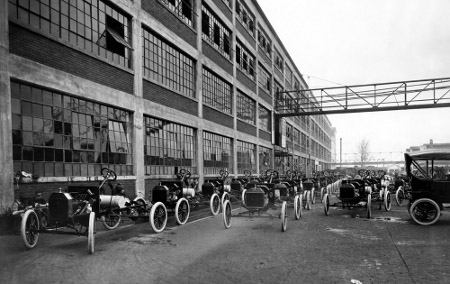 An early picture from the famed Highland Park Assembly Plant where the moving assembly line was born.
An early picture from the famed Highland Park Assembly Plant where the moving assembly line was born.
Before the dawn of the computing age and robotics, most automotive assembly line workers did everything by hand or used wires and cables for actual fabrication practices.
In the beginning, auto workers held tough, industrial jobs such as loading head linings and wind laces onto conveyors, or assembling oil pans and painting sheet metal parts in a matter of seconds. Not only did these jobs require operators to have precise physical skills, but they also had to be done quickly and efficiently or the forward sections of the line would be slowed down.
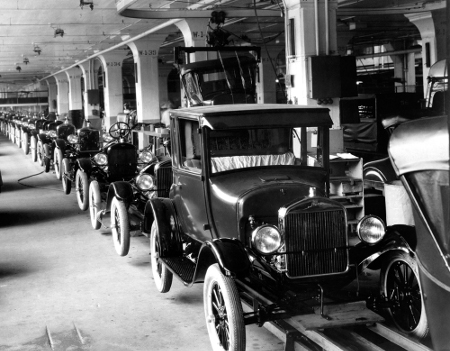 An early picture of newly assembled Ford Model T's.
An early picture of newly assembled Ford Model T's.
During the early days of Ford Motor Co., Henry Ford’s vision for a moving assembly line was realized in the famous Highland Park Assembly Plant. Ford imagined a manufacturing system in which workers would be responsible for assembling a portion of the automobile while the bodies were constantly moving forward. When a Model T reached the end of the line, the operators would drive the newly assembled cars off the shop floor.
Before the invention of the self starter, the workers would run the rear wheels between the revolving steel drums with the vehicle in gear, and this process helped to start the motors. After construction of the Highland Park plant was finished in 1910, auto manufacturing intensified in Detroit and around the globe.
By 1914, Henry Ford had directed that all Model T automobiles be painted one color - black. The reason being was that black enamel paint dried faster than any other color. At that time, it took a single car roughly 93 minutes or more to be manufactured on the assembly line. On Jan. 5, 1914, Henry Ford’s famous $5 per day wage was announced. This was well more than the previous rate and jumpstarted a massive migration of people from all across the country to the Detroit area.
Russ Banham, in his popular book “The Ford Century,” said this about early assembly line Ford manufacturing “On this historic day (October 7, 1913) the company rigged a rudimentary final assembly line at Highland Park, whereby a chassis was pulled slowly across the factory floor by rope and windlass. Parts, components and 140 assemblers were stationed at different intervals along the 150-foot line. As the winch literally dragged the chassis across the floor, workers attached parts to the car. When the car was finished, the production men were amazed at the time saved.”
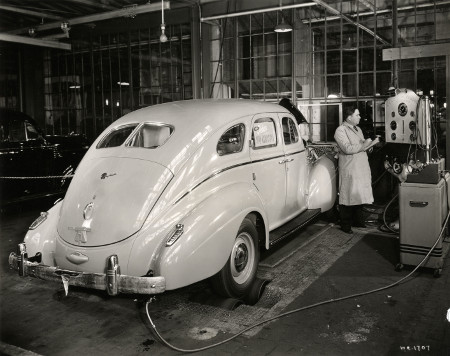 A newly finished Chrysler car undegoing inspection before leaving the factory.
A newly finished Chrysler car undegoing inspection before leaving the factory.
In 1929, the Chrysler Corporation used a stationary body drop process in which the chassis was pushed onto the conveyor, and then an operator in an overhead crane dropped the body onto the chassis. It took at least three men to line up the body and the chassis and then unhook the straps that held the body in place. The process was a long and tedious job.
Times have certainly changed with the improvements that have come along with technology. Today's assembly line methods can produce over 100 cars per hour. During the early days, most automobile companies used a machine called the telautograph, for example like in the photographs that are a part of this story.
 Men in the Chrysler controller room reading through print outs.
Men in the Chrysler controller room reading through print outs.
On July 31, 1888, electrical engineer Elisha Gray patented the telautograph machine. The telautograph is considered an early predecessor to the fax machine with its ability to transmit handwriting through telegraph machines. Gray’s telautograph became very popular in automotive as it was used for orders and track sheets that controlled the flow of parts and materials up to the assembly lines during the manufacturing process.
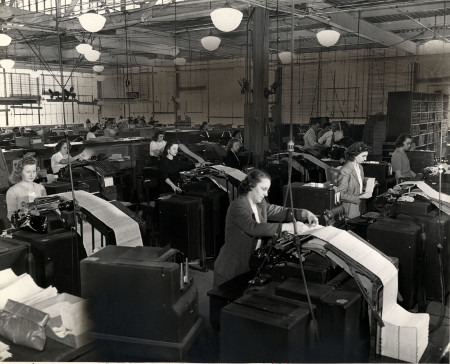 Women factory workers typing information for Chrysler Assembly.
Women factory workers typing information for Chrysler Assembly.
Other jobs included the swinging gate line which was used at the start of the main gate line as the sides of a car body were swung into position and clamped to the floor pan by the factory workers. Moments later the roof would be placed and the body solidly welded together. Today, robotics have replaced this method and many others to improve and simplify the auto manufacturing process. During the early 1940s, Buick factory workers used fender presses to form Buick's one-piece front fender hood-side and headlamp body in a single operation.
Cadillac, Chrysler and Ford along with other automotive manufacturing companies could receive final testing results on new automobiles before leaving the factory floor and showing up in dealer show rooms for the customers.
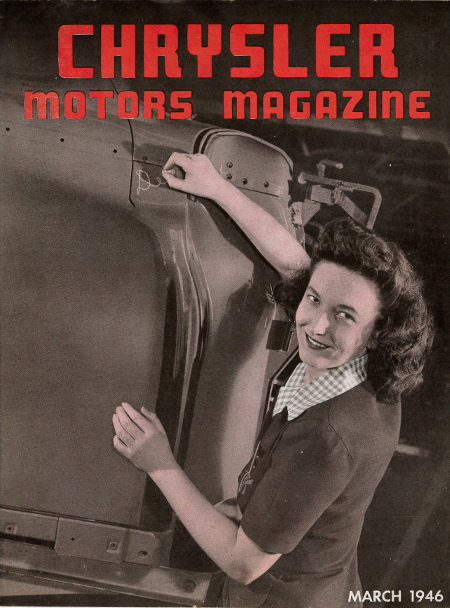 Annie Kammer of DeSoto is hand-wiring codes on the body of the car.
Annie Kammer of DeSoto is hand-wiring codes on the body of the car.
After WWII and Franklin D. Roosevelt’s famed Arsenal of Democracy, the auto companies faced a sizable problem now that they had to convert their war machine assembly lines back to its peacetime business of building great cars. Due to the interruption caused by the war, it was necessary to completely rearrange the automotive plants before automobile production could be resumed.
On an historical note, we can thank the men and women factory workers who had worked countless hours in tough conditions to perpetually move the domestic automotive industry forward thus engendering a more thrivent middle class. It was their hard work and dedication after the war that created ripple effects that can be felt today.
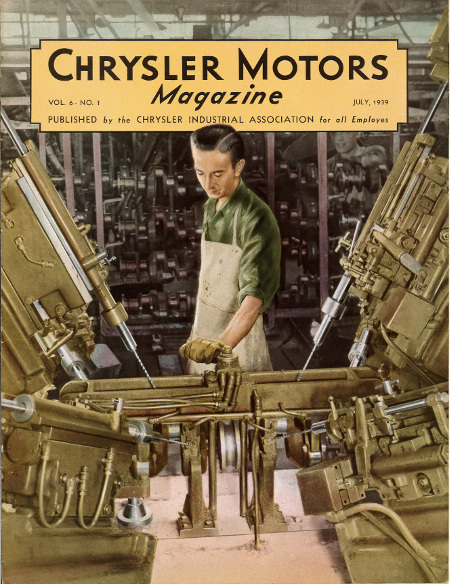 Dwight Hanselman drill holes in crankshafts.
Dwight Hanselman drill holes in crankshafts.



